Pasta Market
Pasta Market Size and Share Forecast Outlook 2025 to 2035
Pasta market is projected to grow from USD 31.5 billion in 2025 to USD 40.2 billion by 2035, at a CAGR of 2.5%. Dried will dominate with a 70.0% market share, while retail will lead the distribution segment with a 80.0% share.
Pasta Market Forecast and Outlook 2025 to 2035
The pasta market approaches a decade of measured growth that will transform food processing and consumption patterns across retail, food service, and industrial applications. The market's trajectory from USD 31,500.0 million in 2025 to USD 40,200.0 million by 2035 represents controlled expansion, the market will rise at a CAGR of 2.5% which demonstrating steady adoption of pasta products and culinary diversification across cooking applications, food service operations, and consumer dining preferences worldwide.
The first half of the decade (2025-2030) will witness the market climbing from USD 31,500.0 million to approximately USD 35,100.0 million, adding USD 3,600.0 million in value, which constitutes 41% of the total forecast growth period. This phase will be characterized by continued adoption of retail and food service applications, driven by increasing consumer demand and the growing need for convenient meal solutions in cooking and dining applications globally. Enhanced distribution capabilities and automated supply chain systems will become standard expectations rather than premium options.
Quick Stats for Pasta Market
- Pasta Market Value (2025): USD 31,500.0 million
- Pasta Market Forecast Value (2035): USD 40,200.0 million
- Pasta Market Forecast CAGR: 2.5%
- Leading Type in Pasta Market: Dried Pasta Segment
- Key Growth Regions in Pasta Market: East Asia, Western Europe, and North America
- Top Players in Pasta Market: Barilla, Ebro Foods, Nestlé, De Cecco, Grupo Gallo
- Where revenue comes from - now vs next (industry-level view)
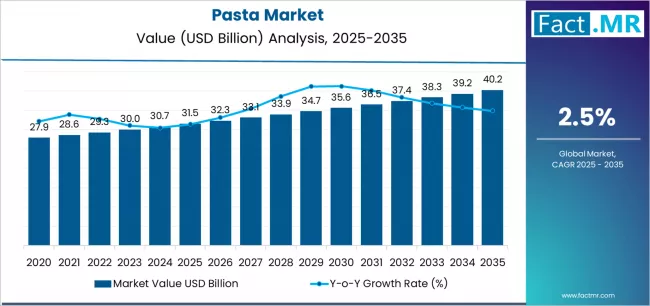
The latter half (2030-2035) will witness continued growth from USD 35,100.0 million to USD 40,200.0 million, representing an addition of USD 5,100.0 million or 59% of the decade's expansion. This period will be defined by mass market penetration of specialty and gluten-free pasta products, integration with comprehensive food service platforms, and compatibility with existing retail infrastructure. The market trajectory signals fundamental shifts in how consumers approach meal preparation and dining operations, with participants positioned to benefit from growing demand across multiple application segments and distribution channels.
Pasta manufacturing encompasses comprehensive grain processing systems coordinating dried, fresh, and specialty formulations across diverse consumer, food service, and retail applications. Durum wheat varieties provide enhanced texture characteristics and cooking consistency suitable for traditional pasta preparation methods. Dried pasta configurations dominate retail markets through extended shelf life capabilities and convenient storage characteristics.
Consumer applications drive primary market demand through requirements for meal preparation, cooking versatility, and nutritional content across household dining and food preparation activities. Specialty formulations address dietary restrictions including gluten-free alternatives using rice flour, quinoa, and alternative grain compositions. Fresh pasta applications emphasize premium positioning and restaurant-quality preparation for enhanced dining experiences.
Food service applications encompass restaurant operations, commercial kitchens, and institutional feeding requiring bulk processing capabilities and consistent preparation standards. Industrial processing utilizes specialized equipment for large-scale production supporting retail distribution and commercial food preparation operations. Quality control systems ensure consistent texture, cooking performance, and shelf stability across manufacturing processes.
Emerging trends in the pasta market include increased innovation in protein-enriched and plant-based formulations, catering to health-conscious consumers and flexitarian diets. Ready-to-cook and microwaveable pasta products are gaining traction, driven by convenience and time-saving preferences. Additionally, e-commerce and direct-to-consumer channels are expanding market reach, enabling smaller brands and artisanal producers to access broader audiences while supporting customized and regionally inspired pasta offerings.
| Period | Primary Revenue Buckets | Share | Notes |
|---|---|---|---|
| Today | Dried pasta applications | 70% | Volume-driven, convenience focus |
| Fresh pasta products | 20% | Premium positioning, restaurant quality | |
| Specialty/gluten-free alternatives | 10% | Health-driven, dietary requirements | |
| Durum wheat formulations | 85% | Traditional processing method | |
| Alternative grain products | 15% | Health and specialty applications | |
| Future (3-5 yrs) | Enhanced dried systems | 68-72% | Technology integration, quality improvement |
| Expanded fresh solutions | 18-22% | Restaurant growth, premium demand | |
| Advanced specialty products | 8-12% | Health awareness, dietary diversification | |
| Optimized durum processing | 82-88% | Production enhancement, quality consistency | |
| Alternative grain expansion | 12-18% | Health trends, ingredient innovation | |
| Digital retail platforms | 3-5% | E-commerce integration, direct sales |
Pasta Market Key Takeaways
At-a-Glance Metrics
| Metric | Value |
|---|---|
| Market Value (2025) → | USD 31,500.0 million |
| Market Forecast (2035) ↑ | USD 40,200.0 million |
| Growth Rate ★ | 2.5% CAGR |
| Leading Type → | Dried Pasta Segment |
| Primary Distribution → | Retail Channel |
The market demonstrates strong fundamentals with dried pasta products capturing a dominant share through reliable cooking capabilities and storage optimization. Durum wheat applications drive primary demand, supported by increasing consumer requirements and operational culinary development.
Geographic expansion remains concentrated in developed markets with established food infrastructure, while emerging economies show accelerating adoption rates driven by dietary modernization initiatives and rising food accessibility standards.
Imperatives for Stakeholders in Pasta Market
Design for culinary versatility, not just product variety
- Offer complete meal packages: pasta products + cooking instructions + sauce recommendations + nutritional guidance + recipe support.
- Preconfigured workflows: cooking schedules, preparation procedures, serving protocols, and storage recommendations for consumer operations.
Technology readiness for Food 4.0
- Real-time inventory monitoring analytics, predictive demand capabilities, and smart kitchen integration (IoT connectivity, cooking tracking systems).
Quality-by-design approach
- Automated quality monitoring systems, real-time production diagnostics, certified cooking procedures, and digital nutrition documentation.
Value-based pricing models
- Clear base product price + transparent quality tiers (ingredient sourcing, preparation support, nutrition guarantees); subscriptions for specialty products and services.
Segmental Analysis
The pasta market is segmented by type into dried (70%), fresh (20%), and specialty/gluten-free (10%) varieties, reflecting the transition from basic food processing methods to specialized culinary solutions designed for comprehensive meal preparation and dietary optimization.
Distribution channels are divided into retail (80%), food service (15%), and industrial (5%), highlighting differing requirements for consumer accessibility, commercial operations, and processing efficiency. The grain category is segmented into durum wheat (85%) and alternative grains (15%), demonstrating diverse ingredient needs and nutritional optimization standards.
The segmentation structure illustrates a technological progression from standard food processing toward specialized pasta offerings with enhanced culinary consistency and nutritional benefits. Distribution diversity spans consumer retail to commercial food service, emphasizing the need for precise preparation solutions across varying applications.
By Type, the Dried Pasta Segment Accounts for Dominant Market Share
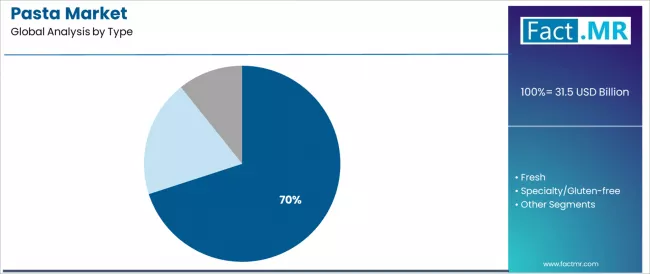
Dried pasta holds a leading position in the pasta market, commanding a 70% share, driven by its superior shelf life, storage stability, cooking convenience, and ease of preparation, which allow consumers to achieve consistent results across a wide range of culinary and meal preparation scenarios.
Dried pasta demand receives traction from strong consumer preference for convenient food products that deliver reliable cooking performance, extended storage without refrigeration, and efficient preparation. Advanced processing ensures consistent texture, predictable cooking times, and seamless compatibility with standard kitchen equipment, meeting critical requirements for performance and convenience.
Dried pasta distinguishes itself through established storage reliability, uniform cooking characteristics, and compatibility with inventory management practices, enhancing overall meal preparation efficiency while maintaining high quality standards across diverse culinary applications.
Key market characteristics:
- Advanced processing designs with optimized texture configuration and cooking efficiency capabilities
- Enhanced preparation effectiveness, enabling 95-98% cooking consistency with reliable texture performance
- Kitchen compatibility, including portion control systems, cooking integration, and process optimization for meal control
Fresh Pasta Applications Show Premium Market Growth
Fresh pasta applications maintain a 20% market position in the pasta market due to their enhanced texture properties and restaurant-quality characteristics. These systems appeal to consumers requiring premium performance with superior positioning for culinary and fine dining applications. Market growth is driven by restaurant segment expansion, emphasizing quality preparation solutions and operational efficiency through optimized fresh designs.
Specialty/Gluten-Free Applications Demonstrate Dietary Solutions
Specialty and gluten-free pasta applications capture 10% market share through specialized dietary requirements in health-conscious cooking, medical dietary needs, and alternative ingredient applications. These operations demand certified dietary systems capable of operating with food restrictions while providing effective nutritional integration and cooking performance capabilities.
By Distribution, Retail Channel Shows Market Leadership
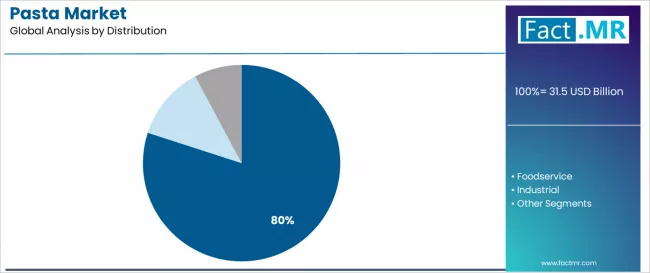
Retail distribution leads the pasta market, accounting for an 80% share, driven by widespread adoption of consumer food products and a strong focus on shopping convenience, meal planning flexibility, and accessible cooking solutions that maintain quality standards.
Consumers favor retail channels for their convenience, product availability, and seamless integration with existing kitchen practices, enabling efficient meal preparation across diverse cooking applications. The segment is further supported by significant retail investments and modernization initiatives that prioritize a variety of pasta offerings to optimize meal planning and cooking accessibility.
Expansion of consumer shopping activities continues to reinforce pasta’s presence in retail, while increasing demand for reliable product availability ensures compliance with quality standards and reduces preparation complexity.
Food Service Distribution Maintains Commercial Demand
Food service distribution captures 15% market share through comprehensive meal requirements in restaurant operations, commercial kitchens, and large-scale food preparation applications. These operations demand reliable supply systems capable of handling substantial volumes while providing effective meal management and cooking performance capabilities.
Industrial Distribution Shows Processing Growth
Industrial distribution accounts for 5% market share, including food processing operations, manufacturing applications, and bulk preparation requiring specialized processing solutions for operational optimization and production accessibility.
By Grain, Durum Wheat Shows Market Leadership
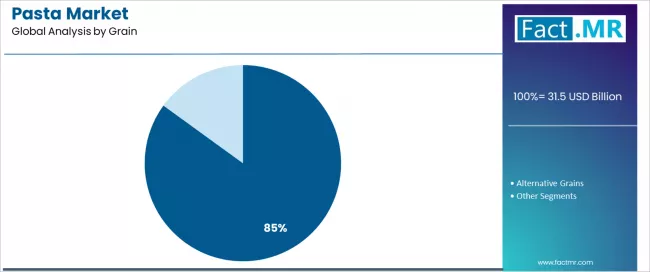
Durum wheat formulations lead the pasta market, accounting for an 85% share, driven by widespread adoption of traditional grain processing and a strong focus on cooking quality, texture consistency, and overall performance while maintaining taste standards. Manufacturers value durum wheat for its ingredient consistency, reliable cooking characteristics, and seamless integration with existing processing infrastructure, enabling coordinated production across multiple pasta varieties.
The segment is further supported by significant agricultural investments and supply initiatives that prioritize durum wheat for quality optimization and production efficiency. Expansion of processing facilities continues to reinforce durum wheat as the standard ingredient for pasta production, while growing consumer demand drives the need for consistent cooking performance that adheres to quality standards and reduces preparation complexity.
Application dynamics include:
- Strong growth in processing facilities and production operations requiring reliable ingredient capabilities
- Increasing adoption in quality optimization and operational efficiency applications for manufacturers
- Rising integration with automated processing systems for operational optimization and quality assurance
Alternative Grains Maintain Specialty Demand
Alternative grains capture 15% market share through comprehensive dietary requirements in health-conscious applications, specialty cooking, and nutritional enhancement requiring reliable ingredient systems capable of operating with dietary restrictions while providing effective nutritional management and cooking performance capabilities.
What are the Drivers, Restraints, and Key Trends of the Pasta Market?
| Category | Factor | Impact | Why It Matters |
|---|---|---|---|
| Driver | Consumer convenience demand & meal preparation (cooking efficiency, meal planning) | ★★★★★ | Large-scale consumer markets require efficient, reliable meal solutions with consistent performance and preparation convenience across cooking applications. |
| Driver | Food service growth & restaurant expansion | ★★★★★ | Drives demand for specialized pasta solutions and high-quality cooking capabilities; suppliers providing commercial-grade products gain competitive advantage. |
| Driver | Health awareness & dietary diversification (gluten-free options, nutrition focus) | ★★★★☆ | Consumer markets need specialized dietary solutions; demand for alternative formulations expanding addressable market segments. |
| Restraint | Raw material costs & grain price volatility | ★★★★☆ | Small producers face cost pressure; increases price sensitivity and affects supply consistency in budget-sensitive markets. |
| Restraint | Rice and bread competition & alternative carbohydrates | ★★★☆☆ | Cost-focused applications face challenges with meal selection and dietary requirements, limiting adoption in price-sensitive segments. |
| Trend | Specialty products adoption & dietary alternatives (gluten-free expansion) | ★★★★★ | Growing demand for specialized food solutions; dietary integration becomes core value proposition in health-conscious segments. |
| Trend | Asian market expansion & regional cuisine integration | ★★★★☆ | Regional culinary development drives demand for pasta adaptation; local cooking capabilities drive competition toward localization. |
Analysis of the Pasta Market by Key Country
The pasta market exhibits diverse regional dynamics, with India and China leading growth at CAGRs of 3.4% and 2.9%, respectively, driven by dietary initiatives and the expansion of culinary capabilities. Steady performers include Italy (2.8%), Brazil (2.6%), and the USA (2.4%), benefiting from established food industries and advanced culinary adoption. Mature markets such as Russia (2.3%) and the United Kingdom (2.2%) demonstrate consistent growth, supported by advancements in food technology and evolving consumer preferences.
Markets in South Asia and East Asia are at the forefront of adoption, fueled by dietary expansion and culinary development, while Western markets maintain steady growth supported by technological advancements and consumer preference trends. Emerging markets are experiencing robust growth, driven by the expansion of food service applications and modernization of dietary habits.
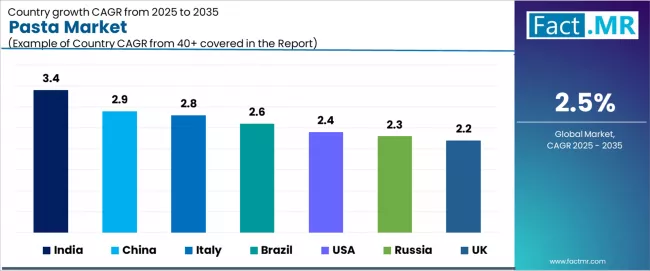
| Region/Country | 2025-2035 Growth | How to win | What to watch out |
|---|---|---|---|
| India | 3.4% | Focus on cost-effective food solutions | Infrastructure challenges; distribution availability |
| China | 2.9% | Lead with high-volume supply systems | Food regulations; dietary complexity |
| Italy | 2.8% | Premium quality positioning | Market saturation; traditional competition |
| Brazil | 2.6% | Offer comprehensive distribution | Economic volatility; currency fluctuation |
| USA | 2.4% | Provide convenience-focused applications | Health regulations; ingredient requirements |
| Russia | 2.3% | Push industrial integration solutions | Economic sanctions; supply constraints |
| UK | 2.2% | Premium convenience positioning | Brexit impacts; supply chain complexity |
India Drives Fastest Market Growth
India establishes fastest market growth through comprehensive dietary programs and expanding food service capacity development, integrating pasta products as emerging components in urban cooking and commercial food installations. The country's 3.4% growth rate reflects urbanization initiatives promoting culinary modernization and food diversity capabilities that encourage adoption of international cuisine systems in cooking facilities.
Growth concentrates in major urban centers, including Mumbai, Delhi, and Bangalore, where culinary technology development showcases integrated food systems that appeal to consumers seeking advanced meal diversification capabilities and operational cooking applications.
Indian food distributors are developing cost-effective pasta solutions that combine domestic distribution advantages with international culinary features, including automated retail systems and enhanced availability capabilities. Distribution channels through food retailers and restaurant suppliers expand market access, while urbanization support for culinary development supports adoption across diverse consumer segments.
Strategic Market Indicators:
- Urban households leading adoption with 45% deployment rate in cooking systems and food sectors
- Restaurant industry programs providing demand for international cuisine development
- Local food providers capturing 38% market share through competitive pricing and localized distribution support
- Export market development for regional pasta adaptations targeting South Asian culinary markets
China Emerges as High-Volume Market
In Guangdong, Jiangsu, and Zhejiang provinces, food facilities and restaurant operations are implementing pasta products as standard menu components for culinary optimization and operational food enhancement, driven by increasing consumer dietary investment and food modernization programs that emphasize the importance of international cuisine capabilities. The market holds a 2.9% growth rate, supported by urbanization initiatives and dietary infrastructure development programs that promote diverse food systems for cooking facilities.
Chinese operators are adopting food systems that provide consistent culinary performance and safety compliance features, appealing in urban regions where meal efficiency and food standards represent critical operational requirements. Market expansion benefits from growing food processing capabilities and restaurant integration agreements that enable domestic production of adapted pasta systems for Chinese applications.
Italy Shows Premium Quality Market Development
Italy establishes premium quality market development through traditional food programs and established culinary infrastructure, integrating pasta systems across household facilities and restaurant applications. The country's 2.8% growth rate reflects mature food industry relationships and established culinary adoption that supports widespread use of pasta systems in cooking facilities and quality-focused operations. Growth concentrates in major culinary centers, including Rome, Milan, and Bologna, where food technology showcases traditional pasta deployment that appeals to consumers seeking proven quality capabilities and culinary excellence applications.
Italian producers leverage established culinary networks and comprehensive quality capabilities, including tradition programs and technical expertise that create consumer relationships and operational advantages. The market benefits from established culinary standards and quality requirements that support pasta system use while supporting technology advancement and culinary optimization.
Brazil Demonstrates Distribution Development
Brazil establishes comprehensive distribution development through expanding food programs and developing retail infrastructure, integrating pasta systems across urban facilities and food service applications. The country's 2.6% growth rate reflects growing food industry relationships and increasing culinary adoption that supports expanding use of pasta systems in cooking facilities and distribution-oriented operations.
Growth concentrates in major urban centers, including São Paulo, Rio de Janeiro, and Belo Horizonte, where food technology development showcases integrated distribution systems that appeal to consumers seeking accessible food solutions with operational efficiency compatibility.
Brazilian distributors focus on maintaining supply standards while adopting food distribution efficiency, creating demand for systems that balance availability with operational advantages. The market benefits from strong retail infrastructure and growing culinary opportunities that support pasta technology adoption while maintaining supply standards important to Brazilian food applications.
USA Shows Convenience-Focused Market Development
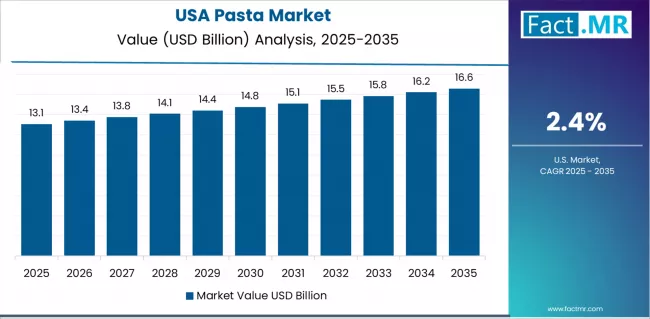
USA establishes convenience-focused market development through comprehensive food programs and established retail infrastructure, integrating pasta products across household facilities and food service applications. The country's 2.4% growth rate reflects mature food industry relationships and established convenience adoption that supports widespread use of pasta systems in cooking facilities and convenience-oriented operations.
Growth concentrates in major retail centers, including California, Texas, and New York, where food technology showcases mature convenience deployment that appeals to consumers seeking proven convenience capabilities and meal preparation applications.
American distributors leverage established retail networks and comprehensive convenience capabilities, including meal programs and preparation support that create consumer relationships and operational advantages. The market benefits from mature food standards and convenience requirements that support pasta system use while supporting technology advancement and meal optimization.
Russia Shows Industrial Integration Development
Russia establishes industrial integration development through comprehensive food modernization and production integration, integrating pasta systems across food processing facilities and institutional applications. The country's 2.3% growth rate reflects growing industrial investment and increasing adoption of food technology that supports expanding use of pasta systems in Russian food facilities.
Growth concentrates in major industrial areas, including Moscow, St. Petersburg, and Novosibirsk, where food technology development showcases integrated pasta systems that appeal to Russian operators seeking advanced industrial solutions with production efficiency compatibility.
Russian operators focus on maintaining production standards while adopting industrial food efficiency, creating demand for systems that balance performance with operational advantages. The market benefits from strong industrial infrastructure and growing production opportunities that support pasta technology adoption while maintaining quality standards important to Russian industrial applications.
UK Demonstrates Premium Convenience Focus
UK establishes premium convenience market development through advanced food programs and established retail infrastructure, integrating pasta systems across household facilities and convenience applications. The country's 2.2% growth rate reflects growing food industry relationships and established convenience adoption that supports widespread use of pasta systems in cooking facilities and premium-oriented operations. Growth concentrates in major retail centers, including London, Manchester, and Birmingham, where food technology showcases premium convenience deployment that appeals to consumers seeking proven premium capabilities and meal convenience applications.
British retailers leverage established convenience networks and comprehensive premium capabilities, including meal programs and quality support that create consumer relationships and operational advantages. The market benefits from established food standards and premium requirements that support pasta system use while supporting technology advancement and convenience optimization.
Europe Market Split by Country
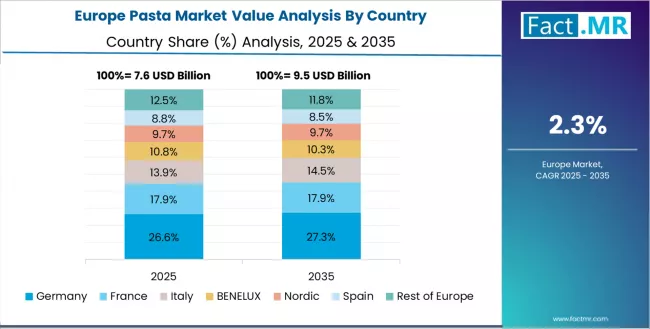
The pasta market in Europe is projected to account for a significant share of global consumption, with robust distribution across major economies. Germany is expected to retain its leadership, representing USD 6,500.0 million in 2025, supported by advanced food infrastructure and major retail hubs.
The UK follows with USD 4,800.0 million, driven by comprehensive food programs and initiatives focused on convenience and technological advancements. France accounts for USD 3,900.0 million, underpinned by specialized culinary applications and compliance with food standards. Italy holds USD 3,200.0 million, while Spain represents USD 2,700.0 million in 2025.
The rest of Europe collectively maintains USD 9,400.0 million, reflecting growing adoption of pasta products in Nordic countries and emerging food facilities embracing culinary modernization initiatives.
Competitive Landscape of the Pasta Market
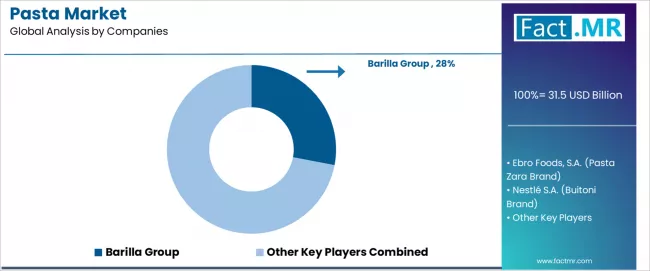
- Structure: 15-20 active players; top 3-4 hold 45-50% by revenue, with Barilla leading at 18.0% market share.
- Leadership is maintained through: global distribution networks, specialized food systems, and regional culinary capabilities (multi-application versatility + quality support + consumer compliance).
- What's commoditizing: standard retail pasta and basic cooking systems.
- Margin Opportunities: specialty dietary applications, premium quality positioning, and comprehensive meal solutions (recipe integration, cooking guidance, nutrition documentation).
| Stakeholder | What they actually control | Typical strengths | Typical blind spots |
|---|---|---|---|
| Global platforms | Distribution networks, broad product portfolios, manufacturing facilities | Proven reliability, multi-region support, comprehensive service | Technology refresh cycles; consumer preference dependency |
| Technology innovators | R&D capabilities; advanced processing systems; quality interfaces | Latest technology first; attractive ROI on specialized applications | Service density outside core regions; customization complexity |
| Regional specialists | Local sourcing, fast delivery, nearby technical support | "Close to market" support; pragmatic pricing; local regulations | Technology gaps; talent retention in food science |
| Application-focused ecosystems | Culinary expertise, technical support, specialized solutions | Lowest application variation; comprehensive culinary support | Scaling costs if overpromised; technology obsolescence |
| Service specialists | Distribution programs, product supply, culinary training | Win service-intensive applications; flexible support | Scalability limitations; narrow market focus |
Key Players in the Pasta Market
- Barilla Group
- Ebro Foods, S.A. (Pasta Zara Brand)
- Nestlé S.A. (Buitoni Brand)
- De Cecco S.p.A.
- Grupo Gallo
- Italpasta S.p.A.
- Pastificio Rana S.p.A.
- Garofalo S.r.l.
- Montebello S.p.A.
- Delverde S.r.l.
- La Molisana S.p.A.
- Ronzoni Foods
- Corman S.A.
- Agnesi S.p.A.
- Divella S.p.A.
Scope of the Report
| Items | Values |
|---|---|
| Quantitative Units (2025) | USD 31,500.0 million |
| Type | Dried, Fresh, Specialty/Gluten-free |
| Distribution | Retail, Foodservice, Industrial |
| Grain | Durum Wheat, Alternative Grains |
| Regions Covered | East Asia, Western Europe, South Asia Pacific, North America, Latin America, Middle East & Africa |
| Countries Covered | Italy, USA, China, Brazil, Russia, India, UK, Germany, France, and 25+ additional countries |
| Key Companies Profiled | Barilla, Ebro Foods, Nestlé, De Cecco, Grupo Gallo, Italpasta, Pastificio Rana, Garofalo, Montebello |
| Additional Attributes | Dollar sales by type and distribution categories, regional adoption trends across East Asia, Western Europe, and South Asia Pacific, competitive landscape with food suppliers and service providers, consumer preferences for cooking consistency and meal reliability, integration with culinary platforms and food monitoring systems, innovations in food technology and distribution enhancement. |
Pasta Market by Segments
-
Type :
- Dried
- Fresh
- Specialty/Gluten-free
-
Distribution :
- Retail
- Foodservice
- Industrial
-
Grain:
- Durum Wheat
- Alternative Grains
-
Region :
- East Asia
- China
- Japan
- South Korea
- South Asia Pacific
- India
- ASEAN
- Australia & New Zealand
- Rest of South Asia Pacific
- Western Europe
- Germany
- France
- United Kingdom
- Italy
- Spain
- Rest of Western Europe
- North America
- United States
- Canada
- Mexico
- Latin America
- Brazil
- Rest of Latin America
- Middle East & Africa
- GCC Countries
- South Africa
- Rest of Middle East & Africa
- East Asia
Table of Content
- Executive Summary
- Global Market Outlook
- Demand to side Trends
- Supply to side Trends
- Technology Roadmap Analysis
- Analysis and Recommendations
- Market Overview
- Market Coverage / Taxonomy
- Market Definition / Scope / Limitations
- Market Background
- Market Dynamics
- Drivers
- Restraints
- Opportunity
- Trends
- Scenario Forecast
- Demand in Optimistic Scenario
- Demand in Likely Scenario
- Demand in Conservative Scenario
- Opportunity Map Analysis
- Product Life Cycle Analysis
- Supply Chain Analysis
- Investment Feasibility Matrix
- Value Chain Analysis
- PESTLE and Porter’s Analysis
- Regulatory Landscape
- Regional Parent Market Outlook
- Production and Consumption Statistics
- Import and Export Statistics
- Market Dynamics
- Global Market Analysis 2020 to 2024 and Forecast, 2025 to 2035
- Historical Market Size Value (USD Million) Analysis, 2020 to 2024
- Current and Future Market Size Value (USD Million) Projections, 2025 to 2035
- Y to o to Y Growth Trend Analysis
- Absolute $ Opportunity Analysis
- Global Market Pricing Analysis 2020 to 2024 and Forecast 2025 to 2035
- Global Market Analysis 2020 to 2024 and Forecast 2025 to 2035, By Type
- Introduction / Key Findings
- Historical Market Size Value (USD Million) Analysis By Type , 2020 to 2024
- Current and Future Market Size Value (USD Million) Analysis and Forecast By Type , 2025 to 2035
- Dried
- Fresh
- Specialty/Gluten-free
- Y to o to Y Growth Trend Analysis By Type , 2020 to 2024
- Absolute $ Opportunity Analysis By Type , 2025 to 2035
- Global Market Analysis 2020 to 2024 and Forecast 2025 to 2035, By Distribution
- Introduction / Key Findings
- Historical Market Size Value (USD Million) Analysis By Distribution, 2020 to 2024
- Current and Future Market Size Value (USD Million) Analysis and Forecast By Distribution, 2025 to 2035
- Retail
- Foodservice
- Industrial
- Y to o to Y Growth Trend Analysis By Distribution, 2020 to 2024
- Absolute $ Opportunity Analysis By Distribution, 2025 to 2035
- Global Market Analysis 2020 to 2024 and Forecast 2025 to 2035, By Grain
- Introduction / Key Findings
- Historical Market Size Value (USD Million) Analysis By Grain, 2020 to 2024
- Current and Future Market Size Value (USD Million) Analysis and Forecast By Grain, 2025 to 2035
- Durum Wheat
- Alternative Grains
- Y to o to Y Growth Trend Analysis By Grain, 2020 to 2024
- Absolute $ Opportunity Analysis By Grain, 2025 to 2035
- Global Market Analysis 2020 to 2024 and Forecast 2025 to 2035, By Region
- Introduction
- Historical Market Size Value (USD Million) Analysis By Region, 2020 to 2024
- Current Market Size Value (USD Million) Analysis and Forecast By Region, 2025 to 2035
- North America
- Latin America
- Western Europe
- Eastern Europe
- East Asia
- South Asia and Pacific
- Middle East & Africa
- Market Attractiveness Analysis By Region
- North America Market Analysis 2020 to 2024 and Forecast 2025 to 2035, By Country
- Historical Market Size Value (USD Million) Trend Analysis By Market Taxonomy, 2020 to 2024
- Market Size Value (USD Million) Forecast By Market Taxonomy, 2025 to 2035
- By Country
- USA
- Canada
- Mexico
- By Type
- By Distribution
- By Grain
- By Country
- Market Attractiveness Analysis
- By Country
- By Type
- By Distribution
- By Grain
- Key Takeaways
- Latin America Market Analysis 2020 to 2024 and Forecast 2025 to 2035, By Country
- Historical Market Size Value (USD Million) Trend Analysis By Market Taxonomy, 2020 to 2024
- Market Size Value (USD Million) Forecast By Market Taxonomy, 2025 to 2035
- By Country
- Brazil
- Chile
- Rest of Latin America
- By Type
- By Distribution
- By Grain
- By Country
- Market Attractiveness Analysis
- By Country
- By Type
- By Distribution
- By Grain
- Key Takeaways
- Western Europe Market Analysis 2020 to 2024 and Forecast 2025 to 2035, By Country
- Historical Market Size Value (USD Million) Trend Analysis By Market Taxonomy, 2020 to 2024
- Market Size Value (USD Million) Forecast By Market Taxonomy, 2025 to 2035
- By Country
- Germany
- UK
- Italy
- Spain
- France
- Nordic
- BENELUX
- Rest of Western Europe
- By Type
- By Distribution
- By Grain
- By Country
- Market Attractiveness Analysis
- By Country
- By Type
- By Distribution
- By Grain
- Key Takeaways
- Eastern Europe Market Analysis 2020 to 2024 and Forecast 2025 to 2035, By Country
- Historical Market Size Value (USD Million) Trend Analysis By Market Taxonomy, 2020 to 2024
- Market Size Value (USD Million) Forecast By Market Taxonomy, 2025 to 2035
- By Country
- Russia
- Poland
- Hungary
- Balkan & Baltic
- Rest of Eastern Europe
- By Type
- By Distribution
- By Grain
- By Country
- Market Attractiveness Analysis
- By Country
- By Type
- By Distribution
- By Grain
- Key Takeaways
- East Asia Market Analysis 2020 to 2024 and Forecast 2025 to 2035, By Country
- Historical Market Size Value (USD Million) Trend Analysis By Market Taxonomy, 2020 to 2024
- Market Size Value (USD Million) Forecast By Market Taxonomy, 2025 to 2035
- By Country
- China
- Japan
- South Korea
- By Type
- By Distribution
- By Grain
- By Country
- Market Attractiveness Analysis
- By Country
- By Type
- By Distribution
- By Grain
- Key Takeaways
- South Asia and Pacific Market Analysis 2020 to 2024 and Forecast 2025 to 2035, By Country
- Historical Market Size Value (USD Million) Trend Analysis By Market Taxonomy, 2020 to 2024
- Market Size Value (USD Million) Forecast By Market Taxonomy, 2025 to 2035
- By Country
- India
- ASEAN
- Australia & New Zealand
- Rest of South Asia and Pacific
- By Type
- By Distribution
- By Grain
- By Country
- Market Attractiveness Analysis
- By Country
- By Type
- By Distribution
- By Grain
- Key Takeaways
- Middle East & Africa Market Analysis 2020 to 2024 and Forecast 2025 to 2035, By Country
- Historical Market Size Value (USD Million) Trend Analysis By Market Taxonomy, 2020 to 2024
- Market Size Value (USD Million) Forecast By Market Taxonomy, 2025 to 2035
- By Country
- Kingdom of Saudi Arabia
- Other GCC Countries
- Turkiye
- South Africa
- Other African Union
- Rest of Middle East & Africa
- By Type
- By Distribution
- By Grain
- By Country
- Market Attractiveness Analysis
- By Country
- By Type
- By Distribution
- By Grain
- Key Takeaways
- Key Countries Market Analysis
- USA
- Pricing Analysis
- Market Share Analysis, 2024
- By Type
- By Distribution
- By Grain
- Canada
- Pricing Analysis
- Market Share Analysis, 2024
- By Type
- By Distribution
- By Grain
- Mexico
- Pricing Analysis
- Market Share Analysis, 2024
- By Type
- By Distribution
- By Grain
- Brazil
- Pricing Analysis
- Market Share Analysis, 2024
- By Type
- By Distribution
- By Grain
- Chile
- Pricing Analysis
- Market Share Analysis, 2024
- By Type
- By Distribution
- By Grain
- Germany
- Pricing Analysis
- Market Share Analysis, 2024
- By Type
- By Distribution
- By Grain
- UK
- Pricing Analysis
- Market Share Analysis, 2024
- By Type
- By Distribution
- By Grain
- Italy
- Pricing Analysis
- Market Share Analysis, 2024
- By Type
- By Distribution
- By Grain
- Spain
- Pricing Analysis
- Market Share Analysis, 2024
- By Type
- By Distribution
- By Grain
- France
- Pricing Analysis
- Market Share Analysis, 2024
- By Type
- By Distribution
- By Grain
- India
- Pricing Analysis
- Market Share Analysis, 2024
- By Type
- By Distribution
- By Grain
- ASEAN
- Pricing Analysis
- Market Share Analysis, 2024
- By Type
- By Distribution
- By Grain
- Australia & New Zealand
- Pricing Analysis
- Market Share Analysis, 2024
- By Type
- By Distribution
- By Grain
- China
- Pricing Analysis
- Market Share Analysis, 2024
- By Type
- By Distribution
- By Grain
- Japan
- Pricing Analysis
- Market Share Analysis, 2024
- By Type
- By Distribution
- By Grain
- South Korea
- Pricing Analysis
- Market Share Analysis, 2024
- By Type
- By Distribution
- By Grain
- Russia
- Pricing Analysis
- Market Share Analysis, 2024
- By Type
- By Distribution
- By Grain
- Poland
- Pricing Analysis
- Market Share Analysis, 2024
- By Type
- By Distribution
- By Grain
- Hungary
- Pricing Analysis
- Market Share Analysis, 2024
- By Type
- By Distribution
- By Grain
- Kingdom of Saudi Arabia
- Pricing Analysis
- Market Share Analysis, 2024
- By Type
- By Distribution
- By Grain
- Turkiye
- Pricing Analysis
- Market Share Analysis, 2024
- By Type
- By Distribution
- By Grain
- South Africa
- Pricing Analysis
- Market Share Analysis, 2024
- By Type
- By Distribution
- By Grain
- USA
- Market Structure Analysis
- Competition Dashboard
- Competition Benchmarking
- Market Share Analysis of Top Players
- By Regional
- By Type
- By Distribution
- By Grain
- Competition Analysis
- Competition Deep Dive
- Barilla Group
- Overview
- Product Portfolio
- Profitability by Market Segments (Product/Age /Sales Channel/Region)
- Sales Footprint
- Strategy Overview
- Marketing Strategy
- Product Strategy
- Channel Strategy
- Ebro Foods, S.A. (Pasta Zara Brand)
- Nestlé S.A. (Buitoni Brand)
- De Cecco S.p.A.
- Grupo Gallo
- Italpasta S.p.A.
- Pastificio Rana S.p.A.
- Garofalo S.r.l.
- Montebello S.p.A.
- Delverde S.r.l.
- La Molisana S.p.A.
- Ronzoni Foods
- Corman S.A.
- Agnesi S.p.A.
- Divella S.p.A.
- Barilla Group
- Competition Deep Dive
- Assumptions & Acronyms Used
- Research Methodology
List Of Table
- Table 1: Global Market Value (USD Million) Forecast by Region, 2020 to 2035
- Table 2: Global Market Value (USD Million) Forecast by Type , 2020 to 2035
- Table 3: Global Market Value (USD Million) Forecast by Distribution, 2020 to 2035
- Table 4: Global Market Value (USD Million) Forecast by Grain, 2020 to 2035
- Table 5: North America Market Value (USD Million) Forecast by Country, 2020 to 2035
- Table 6: North America Market Value (USD Million) Forecast by Type , 2020 to 2035
- Table 7: North America Market Value (USD Million) Forecast by Distribution, 2020 to 2035
- Table 8: North America Market Value (USD Million) Forecast by Grain, 2020 to 2035
- Table 9: Latin America Market Value (USD Million) Forecast by Country, 2020 to 2035
- Table 10: Latin America Market Value (USD Million) Forecast by Type , 2020 to 2035
- Table 11: Latin America Market Value (USD Million) Forecast by Distribution, 2020 to 2035
- Table 12: Latin America Market Value (USD Million) Forecast by Grain, 2020 to 2035
- Table 13: Western Europe Market Value (USD Million) Forecast by Country, 2020 to 2035
- Table 14: Western Europe Market Value (USD Million) Forecast by Type , 2020 to 2035
- Table 15: Western Europe Market Value (USD Million) Forecast by Distribution, 2020 to 2035
- Table 16: Western Europe Market Value (USD Million) Forecast by Grain, 2020 to 2035
- Table 17: Eastern Europe Market Value (USD Million) Forecast by Country, 2020 to 2035
- Table 18: Eastern Europe Market Value (USD Million) Forecast by Type , 2020 to 2035
- Table 19: Eastern Europe Market Value (USD Million) Forecast by Distribution, 2020 to 2035
- Table 20: Eastern Europe Market Value (USD Million) Forecast by Grain, 2020 to 2035
- Table 21: East Asia Market Value (USD Million) Forecast by Country, 2020 to 2035
- Table 22: East Asia Market Value (USD Million) Forecast by Type , 2020 to 2035
- Table 23: East Asia Market Value (USD Million) Forecast by Distribution, 2020 to 2035
- Table 24: East Asia Market Value (USD Million) Forecast by Grain, 2020 to 2035
- Table 25: South Asia and Pacific Market Value (USD Million) Forecast by Country, 2020 to 2035
- Table 26: South Asia and Pacific Market Value (USD Million) Forecast by Type , 2020 to 2035
- Table 27: South Asia and Pacific Market Value (USD Million) Forecast by Distribution, 2020 to 2035
- Table 28: South Asia and Pacific Market Value (USD Million) Forecast by Grain, 2020 to 2035
- Table 29: Middle East & Africa Market Value (USD Million) Forecast by Country, 2020 to 2035
- Table 30: Middle East & Africa Market Value (USD Million) Forecast by Type , 2020 to 2035
- Table 31: Middle East & Africa Market Value (USD Million) Forecast by Distribution, 2020 to 2035
- Table 32: Middle East & Africa Market Value (USD Million) Forecast by Grain, 2020 to 2035
List Of Figures
- Figure 1: Global Market Pricing Analysis
- Figure 2: Global Market Value (USD Million) Forecast 2020-2035
- Figure 3: Global Market Value Share and BPS Analysis by Type , 2025 and 2035
- Figure 4: Global Market Y to o to Y Growth Comparison by Type , 2025-2035
- Figure 5: Global Market Attractiveness Analysis by Type
- Figure 6: Global Market Value Share and BPS Analysis by Distribution, 2025 and 2035
- Figure 7: Global Market Y to o to Y Growth Comparison by Distribution, 2025-2035
- Figure 8: Global Market Attractiveness Analysis by Distribution
- Figure 9: Global Market Value Share and BPS Analysis by Grain, 2025 and 2035
- Figure 10: Global Market Y to o to Y Growth Comparison by Grain, 2025-2035
- Figure 11: Global Market Attractiveness Analysis by Grain
- Figure 12: Global Market Value (USD Million) Share and BPS Analysis by Region, 2025 and 2035
- Figure 13: Global Market Y to o to Y Growth Comparison by Region, 2025-2035
- Figure 14: Global Market Attractiveness Analysis by Region
- Figure 15: North America Market Incremental Dollar Opportunity, 2025-2035
- Figure 16: Latin America Market Incremental Dollar Opportunity, 2025-2035
- Figure 17: Western Europe Market Incremental Dollar Opportunity, 2025-2035
- Figure 18: Eastern Europe Market Incremental Dollar Opportunity, 2025-2035
- Figure 19: East Asia Market Incremental Dollar Opportunity, 2025-2035
- Figure 20: South Asia and Pacific Market Incremental Dollar Opportunity, 2025-2035
- Figure 21: Middle East & Africa Market Incremental Dollar Opportunity, 2025-2035
- Figure 22: North America Market Value Share and BPS Analysis by Country, 2025 and 2035
- Figure 23: North America Market Value Share and BPS Analysis by Type , 2025 and 2035
- Figure 24: North America Market Y to o to Y Growth Comparison by Type , 2025-2035
- Figure 25: North America Market Attractiveness Analysis by Type
- Figure 26: North America Market Value Share and BPS Analysis by Distribution, 2025 and 2035
- Figure 27: North America Market Y to o to Y Growth Comparison by Distribution, 2025-2035
- Figure 28: North America Market Attractiveness Analysis by Distribution
- Figure 29: North America Market Value Share and BPS Analysis by Grain, 2025 and 2035
- Figure 30: North America Market Y to o to Y Growth Comparison by Grain, 2025-2035
- Figure 31: North America Market Attractiveness Analysis by Grain
- Figure 32: Latin America Market Value Share and BPS Analysis by Country, 2025 and 2035
- Figure 33: Latin America Market Value Share and BPS Analysis by Type , 2025 and 2035
- Figure 34: Latin America Market Y to o to Y Growth Comparison by Type , 2025-2035
- Figure 35: Latin America Market Attractiveness Analysis by Type
- Figure 36: Latin America Market Value Share and BPS Analysis by Distribution, 2025 and 2035
- Figure 37: Latin America Market Y to o to Y Growth Comparison by Distribution, 2025-2035
- Figure 38: Latin America Market Attractiveness Analysis by Distribution
- Figure 39: Latin America Market Value Share and BPS Analysis by Grain, 2025 and 2035
- Figure 40: Latin America Market Y to o to Y Growth Comparison by Grain, 2025-2035
- Figure 41: Latin America Market Attractiveness Analysis by Grain
- Figure 42: Western Europe Market Value Share and BPS Analysis by Country, 2025 and 2035
- Figure 43: Western Europe Market Value Share and BPS Analysis by Type , 2025 and 2035
- Figure 44: Western Europe Market Y to o to Y Growth Comparison by Type , 2025-2035
- Figure 45: Western Europe Market Attractiveness Analysis by Type
- Figure 46: Western Europe Market Value Share and BPS Analysis by Distribution, 2025 and 2035
- Figure 47: Western Europe Market Y to o to Y Growth Comparison by Distribution, 2025-2035
- Figure 48: Western Europe Market Attractiveness Analysis by Distribution
- Figure 49: Western Europe Market Value Share and BPS Analysis by Grain, 2025 and 2035
- Figure 50: Western Europe Market Y to o to Y Growth Comparison by Grain, 2025-2035
- Figure 51: Western Europe Market Attractiveness Analysis by Grain
- Figure 52: Eastern Europe Market Value Share and BPS Analysis by Country, 2025 and 2035
- Figure 53: Eastern Europe Market Value Share and BPS Analysis by Type , 2025 and 2035
- Figure 54: Eastern Europe Market Y to o to Y Growth Comparison by Type , 2025-2035
- Figure 55: Eastern Europe Market Attractiveness Analysis by Type
- Figure 56: Eastern Europe Market Value Share and BPS Analysis by Distribution, 2025 and 2035
- Figure 57: Eastern Europe Market Y to o to Y Growth Comparison by Distribution, 2025-2035
- Figure 58: Eastern Europe Market Attractiveness Analysis by Distribution
- Figure 59: Eastern Europe Market Value Share and BPS Analysis by Grain, 2025 and 2035
- Figure 60: Eastern Europe Market Y to o to Y Growth Comparison by Grain, 2025-2035
- Figure 61: Eastern Europe Market Attractiveness Analysis by Grain
- Figure 62: East Asia Market Value Share and BPS Analysis by Country, 2025 and 2035
- Figure 63: East Asia Market Value Share and BPS Analysis by Type , 2025 and 2035
- Figure 64: East Asia Market Y to o to Y Growth Comparison by Type , 2025-2035
- Figure 65: East Asia Market Attractiveness Analysis by Type
- Figure 66: East Asia Market Value Share and BPS Analysis by Distribution, 2025 and 2035
- Figure 67: East Asia Market Y to o to Y Growth Comparison by Distribution, 2025-2035
- Figure 68: East Asia Market Attractiveness Analysis by Distribution
- Figure 69: East Asia Market Value Share and BPS Analysis by Grain, 2025 and 2035
- Figure 70: East Asia Market Y to o to Y Growth Comparison by Grain, 2025-2035
- Figure 71: East Asia Market Attractiveness Analysis by Grain
- Figure 72: South Asia and Pacific Market Value Share and BPS Analysis by Country, 2025 and 2035
- Figure 73: South Asia and Pacific Market Value Share and BPS Analysis by Type , 2025 and 2035
- Figure 74: South Asia and Pacific Market Y to o to Y Growth Comparison by Type , 2025-2035
- Figure 75: South Asia and Pacific Market Attractiveness Analysis by Type
- Figure 76: South Asia and Pacific Market Value Share and BPS Analysis by Distribution, 2025 and 2035
- Figure 77: South Asia and Pacific Market Y to o to Y Growth Comparison by Distribution, 2025-2035
- Figure 78: South Asia and Pacific Market Attractiveness Analysis by Distribution
- Figure 79: South Asia and Pacific Market Value Share and BPS Analysis by Grain, 2025 and 2035
- Figure 80: South Asia and Pacific Market Y to o to Y Growth Comparison by Grain, 2025-2035
- Figure 81: South Asia and Pacific Market Attractiveness Analysis by Grain
- Figure 82: Middle East & Africa Market Value Share and BPS Analysis by Country, 2025 and 2035
- Figure 83: Middle East & Africa Market Value Share and BPS Analysis by Type , 2025 and 2035
- Figure 84: Middle East & Africa Market Y to o to Y Growth Comparison by Type , 2025-2035
- Figure 85: Middle East & Africa Market Attractiveness Analysis by Type
- Figure 86: Middle East & Africa Market Value Share and BPS Analysis by Distribution, 2025 and 2035
- Figure 87: Middle East & Africa Market Y to o to Y Growth Comparison by Distribution, 2025-2035
- Figure 88: Middle East & Africa Market Attractiveness Analysis by Distribution
- Figure 89: Middle East & Africa Market Value Share and BPS Analysis by Grain, 2025 and 2035
- Figure 90: Middle East & Africa Market Y to o to Y Growth Comparison by Grain, 2025-2035
- Figure 91: Middle East & Africa Market Attractiveness Analysis by Grain
- Figure 92: Global Market - Tier Structure Analysis
- Figure 93: Global Market - Company Share Analysis
- FAQs -
How big is the pasta market in 2025?
The global pasta market is estimated to be valued at USD 31.5 billion in 2025.
What will be the size of pasta market in 2035?
The market size for the pasta market is projected to reach USD 40.2 billion by 2035.
How much will be the pasta market growth between 2025 and 2035?
The pasta market is expected to grow at a 2.5% CAGR between 2025 and 2035.
What are the key product types in the pasta market?
The key product types in pasta market are dried, fresh and specialty/gluten-free.
Which distribution segment to contribute significant share in the pasta market in 2025?
In terms of distribution, retail segment to command 80.0% share in the pasta market in 2025.